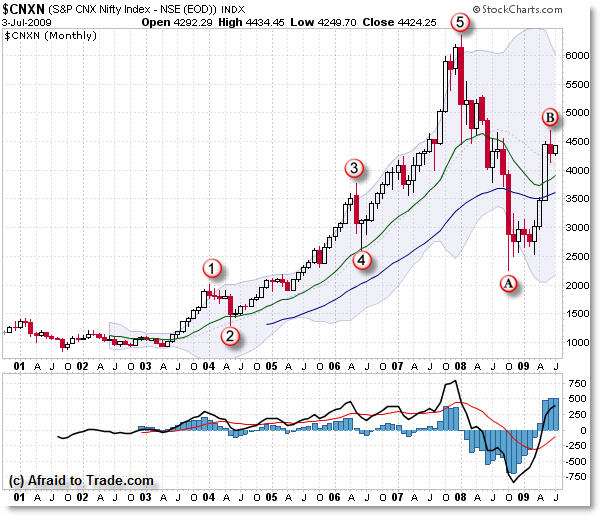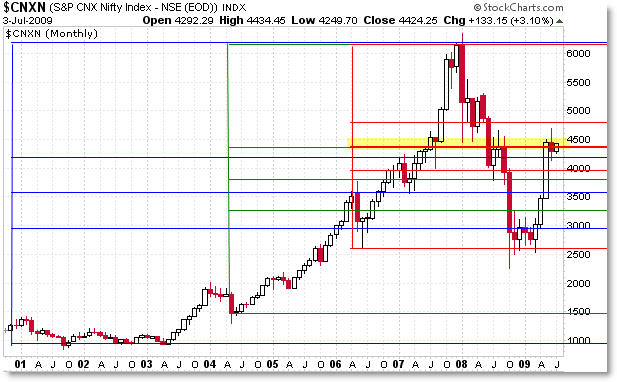Monthly Elliott and Fibonacci Analysis of India’s Nifty July 4
Per multiple reader request (thank you to all my followers in India!), I am updating my analysis on India’s “Nifty 50” Index, beginning this week with the long-term 10-year Monthly Structure.
Let’s take a quick look at a possible large-scale Elliott Wave count and also a Fibonacci Confluence (three price levels) chart on the monthly timeframe – a key turning point may be ahead soon.

The market rallied sharply off the 2003 lows near 1,000 and peaked in January 2008 at a price high of 6,350 – an absolutely impressive rise to be sure.
Look closely and you can see an ‘arc’ rise (not drawn) off these lows as price went ‘parabolic’ in its last few months – a classic warning of a top being formed.
We see the Elliott Wave count (from 1 to 5) as the market rose 600% in value. We now appear to be in a corrective phase, and perhaps are finishing the “B” (second) wave of a larger corrective move to retrace a larger portion of this price rise.
This count would assume that the final “C” Corrective wave down is on the horizon, which could take price back down to test the 2,500 level yet again in the months and perhaps next year to come.
We have already retraced 61.8% of the move from the 2003 lows to the 2008 highs, so perhaps the corrective phase has run its course – that would be the alternate scenario.
The “alternate” scenario would assume that instead of the 5-wave decline I have labeled as “A,” we instead had a complex corrective move down – perhaps in the order of ABC – X – ABC to end the correction, which places us squarely in Wave 1 now of a “new bull market” and expecting a corrective Wave 2 down (not to the lows – but perhaps to the 3,500 level) to begin.
I think it ‘counts better’ as a correction instead of a new bull market, but we need to be open to this possibility.
Either way, the “Next Likely Swing” appears to be a down one, whether it be the final Wave C or just a corrective Wave 2 – that is where I find Elliott Wave helpful – not in absolute forecasting, but in confluence counting in regards to the “next likely swing.”
Speaking of confluence, let’s take a look at a “Confluence Fibonacci Grid” using three price lows to begin our retracement to the closing high in January 2008.

Two of the 3 grids overlap about the 4,400 level, which you see is exactly where price is located now.
In fact, that is the only major overlapping confluence level we see using these grids on the chart.
This implies that price is at a “critical node” and could be unable to overcome this confluence level to the upside – in other words, it could serve as key resistance.
Last month also formed a “Spinning Top” candle, which is often seen and associated with key turning points in a market.
As a caveat, there’s no guarantee of any absolute prediction into the future, but for now, we have the following:
Possible Wave C (or Wave 2) down about to begin
Price at a critical Fibonacci Confluence Node around 4,400
A Spinning Top candle formed in June on the confluence node
A solid close above 4,800 and especially 5,000 would overrule these bearish omens, but until then, it might pay to be defensive on the long side at these levels.
(Note – for US readers, understanding that the Nifty is at confluence resistance ties into the thesis that the S&P 500 is forming a possible reversal pattern down (Monthly “sell signal” and also Daily Head and Shoulders with momentum/volume divergences) – and adds a layer of confirmation that both markets appear poised for corrections).
Corey Rosenbloom, CMT
Afraid to Trade.com
Subscribe for the RSS Feed here.
Follow Corey on Twitter: http://twitter.com/afraidtotrade

Great Analysis! Thankyou for analyzing the India Nifty50 for your followers from India.
Just one quick query. In your analysis/marking of waves on Monthly chart, is wave 5 looking bigger than wave 3? From your cheat sheet I remember that wave 3 has to be the biggest. would this change any of your analysis?
Hey Chandra,
Good question, but the rule officially is “Wave 3 cannot be the shortest wave.”
More times than not, it is the longest because that is where the point of realization takes place, however it is not a requirement – some times wave 5 is the longest because markets can go into a euphoric or parabolic rise right before the trend turns/reverses violently. That’s also what happened in Crude Oil monthly Elliott charts as well.
Thanks Corey. Very useful view for your indian followers. We request you to present atleast one post every month (if possible, a weekly view) with the updated views of Nifty in the coming days. Thank you once again.
Corey,
Nice your web page.
Nikkei have island reversal and bearish wedge.
Let me send you the chart: http://2.bp.blogspot.com/_MJqKtyMMr28/Sk_N4gYiw…
From: http://followmarketrend.blogspot.com/
Great and just u can visit my Website.Iam writing for GLOBAL INDICES ,CRUDE ,FOREX and many more thing.
By the time you read this comment Monday July 6th morning EST, India would have endured a annual ritual of central budget which media has hyped into a make-or-break 'tamasha' – a circus as if other 364 days in the year do not matter. They want all tax concessions and monetary incentives and on the other hand also want reduction of fiscal deficit and the consequent inflation to be contained but still maintain high bank-deposit-savings interest rates. There will be wide swings and where the NIfty will reach today closing is a wild guess. Markets are still to open as I write. This India background is to fill in the USA readers.
I wish to thank Corey for his interest in India and we look forward to his regular updates, and invite him to visit this wonderful part of the world one day.
Wishing you more creative writings
Sandew
Delhi-India
Hi,
really nice analysis of Indian mkt.
this was on monthly charts could u also gv ur views on weekly & Daily charts.
would b of gr8 help.
regards
Visit http://www.fibema.blogspot.com here i discussed same level(4763)approx reversal point but with the help of diffrent indicators . Indicators i use fibonacci and ADX. and my view differs from ur view that mkt will retest lows(2500) again.
As per EW principal wave 3 should not be the smallest when compared to wave 1 and wave 5.
Post Central(Federal) Budget the market tanked. To recap, since March India has had 6 gap-up openings which still not filled – the largest by far being post-election results May 16 when markets hit Upper circuits within few seconds climbing over 15% single day – all on 'hope' and expectations. Budget is perceived to have ailed and hence the corrective 6% downfall on July 6th. Had the budget delievered, the market were earlier expected to cross the threshold of 4650 and thereafter gain momentum upwards towards 5000 – 6000 , the earlier high.
Request to Corey,
1. Please study on weekly and daily maps the GAPS UNFILLED since March
2. Corelation of NIFTY with DOW / SnP 500 which I think is again reemerging.
3. Historical corelation of NIFTY with China's Shanghai COmposite Index. I figure India is far ahead of the historical 1.2 equation and NIfty needs to drift lower (or Shanghai to catch up).
With greetings from India
Sandew
Delhi
Thanks for the insight..
http://learnandteachstocks.blogspot.com/
Get latest articles and information about commodities markets and trade in indian commodities markets with our Free MCX Commodity Tips.Also when you need MCX Trading Live Tips Call us
Moreover if you are interest in BSE Share Tips & NSE Nifty Tips visit us
BullRider provides Indian Stock Market Tips and Share Tips and MCX Commodity Tips for Traders in Indian Financial Markets with high accuracy and reliability
Nice post thank You..
Nifty Tips
Stock Tips
Nice post thank You..
Really amazing analysis of indian market to get clear view of nifty and NSE.
wedding video
Get Fast and 100% accurate MCX TIPS by our expert over here
mcx tips
I
understand this if off topic but I??????m examining starting our weblog
and was curious what all can be get setup? I??????m assuming developing
a blog like yours would cost a pretty penny? I??????m no longer that
internet savvy so I??????m not 100% positive. Any tips or advice would
be greatly appreciated.
Regards,mcx tips free trial
Commodity Ncdex Tips
Mcx Tips
Nice Post thanks.